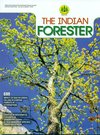Agro Forestry and Sustainable Vegetable Production in Kumaun Lesser Himalaya
DOI:
https://doi.org/10.36808/if/2018/v144i8/93087Keywords:
Agroforestry, Vegetable, Agriculture, Constraints, Socioeconomic.Abstract
The study focused on distribution of tree species and on vegetable crops which are grown under them. The aim was to identify the problem faced by farmers, farm characteristics and methods to improve the production system in kumaun lesser Himalayas of state Uttarakhand in India. A total 90 households were selected on the basis of economic criteria of land holding and occupation as landless, small, medium, big and large farmers. Questionnaires were prepared for survey. Farmers were primarily smallholders with access to less than one hectare of land. A total of 33 tree species were found. The most common species were Prunus persica (29.72), Prunus armenica (22.63), Citrus limon (21.68), Prunus domestica (18.68), while low prevalence species were Actinidia deliciosa (0.304), Melia azedarach (0.447) and Terminalia belerica (0.51). 19 vegetables species were grown in the area with most common being Pisum sativum, Solanum tuberosum, Phaseolus vulgaris, Brassica oleracea and Lycopersicon esculentum. Farmers earned income from selling fruits and vegetables. Vegetable agro forestry was not being conducted in a planned manner primarily due to lack of proper knowledge and awareness amongst farmers followed by frequent landslides in the area. Study concluded that proper training for farmers, enforcement of village by-laws on animal grazing, and facilitation of farmers' access to credit are the major approaches to enhance the adoption of technology. A participatory approach is more likely to achieve success with indigenous people, than the traditional technology transfer approach.References
Chand R. (1997). Agricultural diversification and development of mountain region, book, 249-250 pp.
Deshmukh I. (1986). Ecology and Tropical Biology. Palo Alto, California: Blackwell Scientific Publications.
Nair P.K.R. (1993). An introduction of homegarden agroforestry. ICRAF, Nairobi 1993; 85 pp.
Saka A.R., Bunderson W.T., Mbekeani Y. and Itimu O.A. (1990). Planning and implementation of Agro forestry for small holder farmersin Malawi, In: Planning for agro forestry, Elsevier Applies sci. London, 123-136 pp.
Singh G.B. (1987). Agroforestry in the Indian subcontinent: past, present and future. 117-140 pp.
Soemarwoto O. (1987). Home gardens: a traditional agroforestry system with a promising future. In: Agroforestry: A Decade of Development (H.A. Steppler & P.K.R. Nair (eds.). ICRAF, Nairobi, Kenya. 157-172 pp.
Downloads
Downloads
Published
How to Cite
Issue
Section
License
Unless otherwise stated, copyright or similar rights in all materials presented on the site, including graphical images, are owned by Indian Forester.





